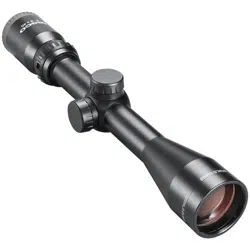Loading ...
Loading ...
Loading ...

5
THE 30/30 RETICLE
All Tasco World Class scope models feature our 30/30 reticle, shown at
right.
PARALLAX
You may have noticed that placing your eye at different positions
behind the scope’s eyepiece causes the reticle crosshairs to appear
to move around to different points on your target. This is called
“parallax error” (target and reticle are not in the same focal plane),
and it becomes more noticeable (and more of a problem) at shorter
distances and/or when the scope is set to higher powers. In most cases,
parallax will not affect bullet point of impact enough to be of significant
concern in large game hunting situations. The 6-18x World Class
model provides an adjustment for parallax compensation (adjustable
objective), which works by moving an optical element until the target
(based on its distance) appears in the same plane of focus as the reticle.
All other World Class scopes are set at the factory to be parallax-free at
100 yards.
USING THE ADJUSTABLE OBJECTIVE (Parallax Compensation on 6-18x Model)
The 6-18x50 model uses a parallax compensation design which internally adjusts the position of the scope’s objective
lens (“adjustable objective” or “AO”). Just line up the estimated distance to your target with the index dot, and you will
eliminate the aiming errors caused by parallax. After setting the adjustable objective, you can double check by moving
your head around from side to side behind the eyepiece-the point of aim should not shift if the side focus is correctly set.
An alternative method is to look through the scope and turn the AO until the target, at whatever range, is sharply focused.
PRELIMINARY SIGHTING-IN
You can save a significant amount of expense and frustration by pre-sighting the scope to the rifle before you take it to
the range for zeroing.
There are two basic methods that can be used for pre-sighting your scope. Method one is to use a Bushnell® Bore Sighter
(laser, magnetic or standard). The use of a Bore Sighter saves time and ammunition and is the system most often used by
gunsmiths. The second method is traditional bore sighting:
BORE SIGHTING METHOD
1. Place a target at 25 to 50 yards.
2. Remove the bolt from the rifle.
3. Place the rifle on sandbags or a shooting rest.
4. Set the scope to its lowest magnification.
5. Peer through the bore from the receiver and adjust the position
of the rifle to center the target bull’s eye in the bore (Fig. A).
6. Without moving the rifle, look into the scope and note the position
of the reticle on the target. Remove the caps from the windage
and elevation adjustments. Adjust the windage and elevation
adjustments to center the reticle on the bull’s eye (Fig. B).
ALTITUDE AND TEMPERATURE
Ballistic charts published by ammunition manufacturers are based upon standard sea level conditions. When sighting in,
it is well to keep in mind that altitude and temperature affect trajectory. It is best to sight-in under the same conditions in
which you will be hunting.
FINAL SIGHTING-IN
WARNING: SINCE THIS PROCEDURE INVOLVES LIVE FIRE, IT SHOULD BE DONE AT AN APPROVED RANGE
OR OTHER SAFE AREA. CHECK BORE FOR OBSTRUCTIONS. AN OBSTRUCTED BORE MAY CAUSE INJURY TO
YOU AND OTHERS NEARBY. EYE AND EAR PROTECTION IS RECOMMENDED.
1. From a steady rest position, fire two or three rounds at a 100-yard target. Note the impact of the bullet on the target
and adjust the windage and elevation dials as needed.
2. To move the bullet impact, turn the windage and/or elevation adjustments in the direction on the dials that corresponds
Fig. A
Reticle not in alignment
Fig. B
Reticle in alignment
TASCO 30/30 RETICLE
Dimensions in MOA
Loading ...
Loading ...
Loading ...
